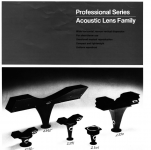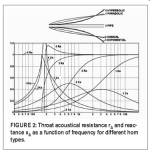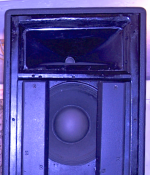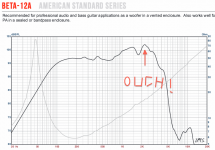I've been building speakers for a while now and I'm working on something I've never done before. I'm building an active/passive 3 way, I have a Eminence Beta 12a-2 that I'll use for the midrange, on top of a Dayton Audio RSS390HO subwoofer. I also have a Selenium D220 compression tweeter that I'll be using, which brings me to my question...
How do you guys decide which lens shape to use? Obviously dispersion, but where is the line drawn? These will be for music, not a PA system or anything like that. I'm going to do a passive cross from the tweeter to the mid, and that will be driven by it's own amp, and I have another amp for the subs which will be crossed using either my B&K preamp, or a MiniDSP if I think I need higher than 200 Hz (B&K only crosses to 200 Hz).
Since I'll be making this out of wood, would anyone be willing to help me figure out the how's and why's to the horn's throat depth, diameter, should I incorporate dispersion strips, etc? I do know how much a waveguide effect's a tweeters usable frequency range, so I imagine this is going to be a journey. I have DATS, as well as an OmniMic for measuring.
This is what I like aesthetically, and ideally what I'm going for. But I'm curious, how much difference does the height of the horn effect the sound quality and dispersion? Or basically, if you guys were building one, which would you choose between these 2 and why? I personally like the looks of both, but the thinner one would work better for keeping the tweeter closer to axis.
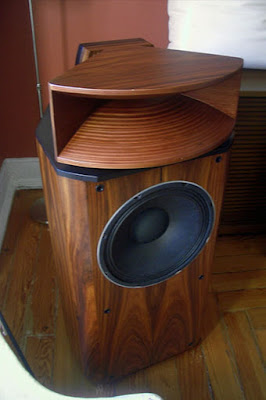

What I have now between my mid cabinet and woofer cabinet is already too tall; generally I try to keep the tweeter's center under 40" in my builds, and these 2 cabinets are already at 43" tall (I've just been kind of making this whole build up as I go along). Put the tweeter on there and it's center is going to be closer to 46". The way I designed the woofer's cabinet, I can cut about 4" off the height and still keep the same cubic airspace, if I did that I would probably just do a 4" round port on the rear of the cabinet. I could do that, or make it so I can tilt the tweeter down using a turnbuckle of sorts on the back of the tweeter.
Here's what I have built so far. If I cut that woofer cabinet down, the base of the woofer cabinet would basically be the top the slot port. Whatever tweeter I design will basically sit on top of that mid cabinet. (The speakers on the right are a passive 3 way I built a little while ago.)

Thanks in advance for any help here!! I know a lot of horn guys are here, so I look forward to hearing from you
How do you guys decide which lens shape to use? Obviously dispersion, but where is the line drawn? These will be for music, not a PA system or anything like that. I'm going to do a passive cross from the tweeter to the mid, and that will be driven by it's own amp, and I have another amp for the subs which will be crossed using either my B&K preamp, or a MiniDSP if I think I need higher than 200 Hz (B&K only crosses to 200 Hz).
Since I'll be making this out of wood, would anyone be willing to help me figure out the how's and why's to the horn's throat depth, diameter, should I incorporate dispersion strips, etc? I do know how much a waveguide effect's a tweeters usable frequency range, so I imagine this is going to be a journey. I have DATS, as well as an OmniMic for measuring.
This is what I like aesthetically, and ideally what I'm going for. But I'm curious, how much difference does the height of the horn effect the sound quality and dispersion? Or basically, if you guys were building one, which would you choose between these 2 and why? I personally like the looks of both, but the thinner one would work better for keeping the tweeter closer to axis.


What I have now between my mid cabinet and woofer cabinet is already too tall; generally I try to keep the tweeter's center under 40" in my builds, and these 2 cabinets are already at 43" tall (I've just been kind of making this whole build up as I go along). Put the tweeter on there and it's center is going to be closer to 46". The way I designed the woofer's cabinet, I can cut about 4" off the height and still keep the same cubic airspace, if I did that I would probably just do a 4" round port on the rear of the cabinet. I could do that, or make it so I can tilt the tweeter down using a turnbuckle of sorts on the back of the tweeter.
Here's what I have built so far. If I cut that woofer cabinet down, the base of the woofer cabinet would basically be the top the slot port. Whatever tweeter I design will basically sit on top of that mid cabinet. (The speakers on the right are a passive 3 way I built a little while ago.)

Thanks in advance for any help here!! I know a lot of horn guys are here, so I look forward to hearing from you
1) My decision for home use would be for a horn that gives uniform response (constant directivity) over the range of use.1)How do you guys decide which lens shape to use?
2)Obviously dispersion, but where is the line drawn?
3)Since I'll be making this out of wood, would anyone be willing to help me figure out the how's and why's to the horn's throat depth, diameter, should I incorporate dispersion strips, etc?
4)This is what I like aesthetically, and ideally what I'm going for. But I'm curious, how much difference does the height of the horn effect the sound quality and dispersion?
5)Or basically, if you guys were building one, which would you choose between these 2 and why? I personally like the looks of both, but the thinner one would work better for keeping the tweeter closer to axis.
2) The line drawn is up to the individual.
3) Those features are part of the chosen horn design.
4) The height of the horn determines the frequency where "pattern flip" will occur, when vertical dispersion becomes wider than horizontal. Basically the horn height must be about a wavelenght of the lowest frequency pattern control is desired to.
5) I'd choose a conical over a radial in terms of pattern control. I'd choose the radial over the Smith (the lower thin distributed source diffraction horn) as the Smith vertical dispersion goes omni below around 3000 Hz, spraying sound onto all sorts of surfaces I'd prefer not to have sprayed. The Smith horns tend to sound "warm and fuzzy", my preference is an accurate reproduction in a defined area.
1) My decision for home use would be for a horn that gives uniform response (constant directivity) over the range of use.
2) The line drawn is up to the individual.
3) Those features are part of the chosen horn design.
4) The height of the horn determines the frequency where "pattern flip" will occur, when vertical dispersion becomes wider than horizontal. Basically the horn height must be about a wavelenght of the lowest frequency pattern control is desired to.
5) I'd choose a conical over a radial in terms of pattern control. I'd choose the radial over the Smith (the lower thin distributed source diffraction horn) as the Smith vertical dispersion goes omni below around 3000 Hz, spraying sound onto all sorts of surfaces I'd prefer not to have sprayed. The Smith horns tend to sound "warm and fuzzy", my preference is an accurate reproduction in a defined area.
Thank you for the response!! So as opposed to the thinner Smith lens, that wider one is technically an "Iwata" lens right?? And between those 2, that Iwata is the design you would choose for a flatter response (the wider one)?
But over both the Iwata and the Smith, you would choose a conical? Any design preferences you would be willing to share? Or, were you saying the Iwata is a conical lens of sorts?
There are also these options as well...



Last edited:
What was said is that if you have a limit to how much height you have, a conical horn will direct the sound lower/more narrow than a horn with a narrow throat.
The Iwata style horn is a radial horn. (Imagine putting four of them side by side in a circle.) If you choose to use this kind of horn the sides fit well with the room walls and give good directivity (see above). The vertical dimension has poorer directivity but in return you get better horn loading.
The Iwata style horn is a radial horn. (Imagine putting four of them side by side in a circle.) If you choose to use this kind of horn the sides fit well with the room walls and give good directivity (see above). The vertical dimension has poorer directivity but in return you get better horn loading.
What was said is that if you have a limit to how much height you have, a conical horn will direct the sound lower/more narrow than a horn with a narrow throat.
The Iwata style horn is a radial horn. (Imagine putting four of them side by side in a circle.) If you choose to use this kind of horn the sides fit well with the room walls and give good directivity (see above). The vertical dimension has poorer directivity but in return you get better horn loading.
Thank you!! When you say the Iwata type gives good directivity, but the vertical dimension has poorer directivity but better horn loading... what exactly does that mean? I know a more directional speaker is going to have poor off axis response, but a better on axis response; but what exactly does "better horn loading" equate to in terms of how they sound?
There is also this style here, but this would be tough to implement given the height I'm already at...

No, I wouldn't say a horn with narrow directivity has 'poor' response off axis, I would just say it has reduced output to the sides. When I said poor directivity I meant it has trouble keeping the beam as narrow, and this has to do with the overall shape of a horn with a narrow throat and a wider mouth.I know a more directional speaker is going to have poor off axis response, but a better on axis response;
Ok, when you do conical it is better with a roundover. This looks like a better option if you design for your own needs.There is also this style here, but this would be tough to implement given the height I'm already at...
1) I am not all that familiar with all the Iwata designs.1) So as opposed to the thinner Smith lens, that wider one is technically an "Iwata" lens right??
2)And between those 2, that Iwata is the design you would choose for a flatter response (the wider one)?
3)But over both the Iwata and the Smith, you would choose a conical?
4)Any design preferences you would be willing to share?
5)Or, were you saying the Iwata is a conical lens of sorts?
2) Without polar and on axis measurements of the two horns it is hard to choose anything, other than the observation that a short horn will diffract at a higher frequency than a tall horn.
3) I would choose a conical with a secondary expansion (the two lower horns in post #3 are single section conical), which then shares loading features of an exponential horn, and avoids "waistbanding" , narrowing midrange then widening of dispersion that conical horns without a secondary expansion exhibit, and reduces mouth diffraction, especially if the transitions are smooth.
4) The one in post #5 looks similar to what I described above. Crossing to a 12" speaker, the vertical height could be around 12" and still have decent vertical pattern control to around 1200 Hz.
Last edited:
You have a lot of great choices for reasonable money these days. There's no need to build you own except for personal satisfaction and finish.
Look at the SEOS, PI, RCF, Faital, Eighteen sound and others for reasonable choices. At least to get you started before the build.
Thereare many things to consider the room, speaker positions and listen position are key. In bright rooms with one or two seats a 60 degree horn might be great. In dead rooms with several seats a 110 degree horn may be best.
Also the acoustic center of the min\high crossover may want the tweeter above, at or under ear level. In my system the AE td15S, Faital 140\142 if I have the horn phase one way the acoustic center is right between the woofer\horn. I flip it the other way now it's above the horn. So, depending on crossover, driver distance and driver phase the patern can be tilted as needed.
You can consider putting the subs on their sides lower the tweeter.
Looks like you'll have an awesome system when you're done.
Scott
Look at the SEOS, PI, RCF, Faital, Eighteen sound and others for reasonable choices. At least to get you started before the build.
Thereare many things to consider the room, speaker positions and listen position are key. In bright rooms with one or two seats a 60 degree horn might be great. In dead rooms with several seats a 110 degree horn may be best.
Also the acoustic center of the min\high crossover may want the tweeter above, at or under ear level. In my system the AE td15S, Faital 140\142 if I have the horn phase one way the acoustic center is right between the woofer\horn. I flip it the other way now it's above the horn. So, depending on crossover, driver distance and driver phase the patern can be tilted as needed.
You can consider putting the subs on their sides lower the tweeter.
Looks like you'll have an awesome system when you're done.
Scott
You have a lot of great choices for reasonable money these days. There's no need to build you own except for personal satisfaction and finish.
Look at the SEOS, PI, RCF, Faital, Eighteen sound and others for reasonable choices. At least to get you started before the build.
+1 the SEOS stuff is quite good and cheap with the matching compression driver. You'll also likely find a passive xo design available that will give you a good starting point.
Coming from a typical cone and dome type speaker you'll probably find a constant directivity waveguide to be quite bright in the top octaves (due to the wider pattern up top) and will want a shelved down response as freq increases. This is where preference comes into play, and you just might find that you prefer a more traditional style horn that has increasing directivity as you go higher in freq......similar to a dome tweeter. If you go to the Auto-Tech website (they make the SEOS waveguides and many trad horns) you can see the directivity pattern for different style horns. I'm a CD wg guy myself.
Want to make a compression horn lens, help please!
You can try pro audio constant directivity horns, as a baseline. Also, Altec 511 or 811 are still cheap and can get your feet wet. They will give you a sense of what horns dynamics can do. I then moved onto older multicell and even a wooden bi-radial. One thing I learned is that the size of your room, listening distance and how big your room is, makes a huge difference in the selection of your horn. Also, horn material makes a big difference in the coloration of the sound which is difficult if not impossible to measure. Starting out with wood horns is a great idea because they will sound very natural with vocals and wood instruments. But they may sound a bit dull on symbols and drums which metal and cast horns really shine. It's a delicate balance for sure.
You can try pro audio constant directivity horns, as a baseline. Also, Altec 511 or 811 are still cheap and can get your feet wet. They will give you a sense of what horns dynamics can do. I then moved onto older multicell and even a wooden bi-radial. One thing I learned is that the size of your room, listening distance and how big your room is, makes a huge difference in the selection of your horn. Also, horn material makes a big difference in the coloration of the sound which is difficult if not impossible to measure. Starting out with wood horns is a great idea because they will sound very natural with vocals and wood instruments. But they may sound a bit dull on symbols and drums which metal and cast horns really shine. It's a delicate balance for sure.
Last edited:
Thanks everybody for the responses. I have this horn lens, plus a larger Eminence lens that's basically the same shape.
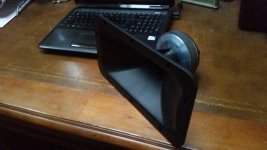
I'll measure this and see how it is. As far as the room, these are going to be in my garage / shop, which is 25 x 27. It's actually not as lively as you would think because the walls are lined with hardwood racks, tools, etc. But it does have a concrete floor.

I'll measure this and see how it is. As far as the room, these are going to be in my garage / shop, which is 25 x 27. It's actually not as lively as you would think because the walls are lined with hardwood racks, tools, etc. But it does have a concrete floor.
If you do want to try making your own wood or core conical horn, you might want to look at the pdf doc and spreadshink that ought to have a link for in my signature below. The spreadsheet will design all the pieces per your specifications. Conical horns are probably the best at directivity control and low coloration, but not great a loading if max spl and efficiency are your target.
If you do want to try making your own wood or core conical horn, you might want to look at the pdf doc and spreadshink that ought to have a link for in my signature below. The spreadsheet will design all the pieces per your specifications. Conical horns are probably the best at directivity control and low coloration, but not great a loading if max spl and efficiency are your target.
So... my goal with these was basically just to have some fun, but I did have one expectation. I've been hugely into stereos my whole life, and I've been building speakers for about 7 (ish?) years now, unless you count sub boxes for cars, then it's been a really long time.
This project came about because I had won these Eminence 12" mids at a speaker show I went to. I was originally going to use them in a pair of PA speakers for my friend's skatepark (that's what I purchased the Selenium D220 tweeters, as well as that lens for), but he ended up getting a pair of speakers that work well for him. So, since I already had most of the drivers, I figured I'd try to build some insanely loud speakers for my shop, but make them as musical and accurate sounding as possible. I think the fact that they'll be in my shop, where I'm never in the same spot for very long, finding a tweeter lens that is less directional might be the better option. But I'm guessing, because I've never done this
I went back and forth on which sub to pick between the Eminence Lab 15 and the Dayton RSS390HO; I chose the Dayton because it had better sensitivity, and it should have a lower f3 in a 3cf cabinet than the Eminence. As far as which is better from a sound quality aspect... time will tell.
So, that's the project. I can build the horn lens out of wood, that won't be a problem. Finding the ideal shape to suit my desired sound is where that gets tricky. Thanks again for all the input!!!
If you do want to try making your own wood or core conical horn, you might want to look at the pdf doc and spreadshink that ought to have a link for in my signature below. The spreadsheet will design all the pieces per your specifications. Conical horns are probably the best at directivity control and low coloration, but not great a loading if max spl and efficiency are your target.
Bill, it just occurred to me who you are (I'm a little slow

Sorry if this reveals my newb status with regards to horns, but this is truly my first time with any kind of... A. horn speaker design... B. (since I've never done a horn speaker) horn lens design. So I'm not very familiar with PA speaker vernacular.
While I do have a vague understanding of what a conical horn is, understanding the line between a conical lens, and one that isn't considered a conical lens is definitely foggy. I also don't know exactly what is taking place when you say "not a great loading"; what exactly is going on when it's "loading"? Is this where you get the lower FR by using the correct lens?
I was told this Beta 12 mid would play out to about 2.5k by a respected individual in the industry. I do understand beaming, and this seems high to me with regards to beaming, but I was going to try it anyhow because I definitely trust this individual's advice. I actually was going to target closer to 2khz from that mid to my tweeter as a starting xover point, but I haven't taken measurements of either the mid or the tweeter yet either, and those will obviously dictate the xover point.
Last edited:
Matt,1) So I'm not very familiar with PA speaker vernacular.
2)While I do have a vague understanding of what a conical horn is, understanding the line between a conical lens, and one that isn't considered a conical lens is definitely foggy. I also don't know exactly what is taking place when you say "not a great loading"; what exactly is going on when it's "loading"? Is this where you get the lower FR by using the correct lens?
3)I was told this Beta 12 mid would play out to about 2.5k by a respected individual in the industry. I do understand beaming, and this seems high to me with regards to beaming, but I was going to try it anyhow because I definitely trust this individual's advice. I actually was going to target closer to 2khz from that mid to my tweeter as a starting xover point, but I haven't taken measurements of either the mid or the tweeter yet either, and those will obviously dictate the xover point.
1) As far as vernacular, those of us long in the tooth are put off by referring to horns as "lenses", as horn lens were a specific sub-species developed by JBL, pictures below.
They consisted of exponential horns with acoustical "lenses" (like Fresnel lenses) in front, and are even more "warm and fuzzy" than DSH (Smith's) horns.
2) This article will get your feet wet regarding horn profiles and their "loading", ie what happens at the lower end of their response curve:
https://www.grc.com/acoustics/an-introduction-to-horn-theory.pdf
I lifted the diagram of horn types below from it.
3) "Play out" is not the same as "sound good" a play can end in a tragedy or a comedy. Given a 1.75" diaphragm 1" exit driver and a Beta 12 I'd probably be looking at around 1500 Hz crossover. An example below is an Eminence Kappa 10 with (my own plywood and putty) 90 x40 conical horn with secondary break, crossed at 1500 Hz it required the 10" to be "shuttered" to get it's dispersion to match the horn's 90 degree pattern at the crossover point.
Art
Attachments
Last edited:
Matt,
1) As far as vernacular, those of us long in the tooth are put off by referring to horns as "lenses", as horn lens were a specific sub-species developed by JBL, pictures below.
They consisted of exponential horns with acoustical "lenses" (like Fresnel lenses) in front, and are even more "warm and fuzzy" than DSH (Smith's) horns.
2) This article will get your feet wet regarding horn profiles and their "loading", ie what happens at the lower end of their response curve:
https://www.grc.com/acoustics/an-introduction-to-horn-theory.pdf
I lifted the diagram of horn types below from it.
3) "Play out" is not the same as "sound good" a play can end in a tragedy or a comedy. Given a 1.75" diaphragm 1" exit driver and a Beta 12 I'd probably be looking at around 1500 Hz crossover. An example below is an Eminence Kappa 10 with (my own plywood and putty) 90 x40 conical horn with secondary break, crossed at 1500 Hz it required the 10" to be "shuttered" to get it's dispersion to match the horn's 90 degree pattern at the crossover point.
Art
Thanks Art!
1. Horns it is then
2. I'll check that out, and thanks for the link
3. This I understand. The guy that said these will work out to 2.5k actually meant they'd work (not just "play out"). I'm definitely not debating this or saying anyone is right or wrong though, all I have is his word. I did do a build in the past using an Eminence Beta 10 with a compression tweeter threaded to the back of that and that was crossed at about 2.3k and they actually sounded amazing. They obviously struggled to dig very low in the bass region, but the mids and highs were incredible.
I'll measure the Beta 12 I have and see where it wants to be. This is that build I did, it was a kit from Meniscus Audio...

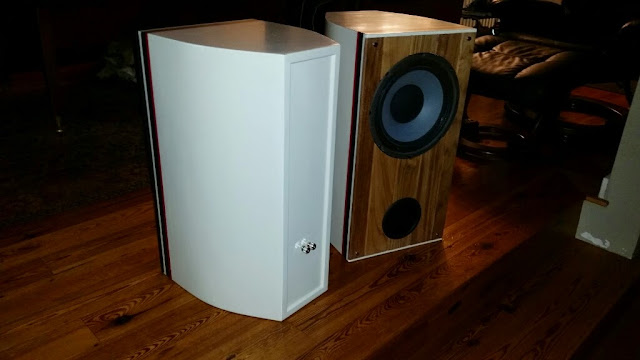
Totally what Art said! I had 2312/2311 with 2308 lenses with 2420/2440 JBL drivers, warm and fuzzy with a definite and insurmountable limit on resolution. Now using 2440 on 2382. So good to avoid the use of the term "lens" since it means something else to most of us.
You should check out Yuichi's site, includes plans and some discussion, here: Yuichi's Audio Lab.
I would be happy to modify the title based on a good suggestion and a request I do so by forum PM.
You should check out Yuichi's site, includes plans and some discussion, here: Yuichi's Audio Lab.
I would be happy to modify the title based on a good suggestion and a request I do so by forum PM.
- Status
- This old topic is closed. If you want to reopen this topic, contact a moderator using the "Report Post" button.
- Home
- Loudspeakers
- Multi-Way
- Want to build high frequency horns, help please!
